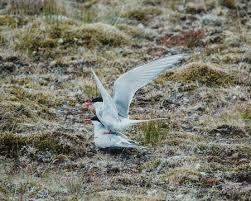
Ah yes... the Arctic Tern — the Casanova of the cryosphere. A creature not just of flight, but of desire, driven by instinct and elegance to perform one of nature’s most daring long-distance hookups. Having traveled tens of thousands of miles from the Antarctic, he arrives — not weary, but ready — in the high Arctic, where the sun never sets and neither, it seems, do his passions.
It is late May or early June, and the tundra is trembling with anticipation.
The male begins his sultry performance: a sky-dance, a balletic aerial flirtation, swooping and gliding with aerodynamic grace. He clutches a small, glistening fish in his beak — not for himself, no, but for her. For in tern society, a fish is foreplay.
Down below, she watches. Cool. Calculating. Coy. If she is suitably impressed by his acrobatics and his generous offering, she accepts it mid-flight in a sensual, synchronized maneuver — an airborne kiss of sorts.
And thus, the pair bond is formed.
Nestled amidst the stony mosses and lichens, they choose a humble scrape in the ground. No lavish nest. No feathers or flair. Just the earth itself — raw and ready.
She lays one to three speckled eggs, the color of salted stone, camouflaged perfectly against the Arctic terrain. Together, they take turns warming their precious cargo, whispering feathered sweet nothings as they swap incubation duties for up to 24 days.
But the passion doesn't end there. The pair defend their territory with furious lust — shrieking, diving, pecking at any intruder with the vengeance of lovers who will not be interrupted. Even humans, scientists, or wayward reindeer beware: one does not get between a tern and its tender endeavor.
By late summer, their downy chicks emerge — ravenous, wide-eyed symbols of avian amour. And soon, before the ice creeps back in, they’ll all take off once more for the endless summer of the Southern Hemisphere.
Yes... in a single year, this bird will fly from the top of the world to the bottom — for food, for light, but most of all... for love.
Truly, the Arctic Tern does not merely migrate — it makes love across the hemispheres.